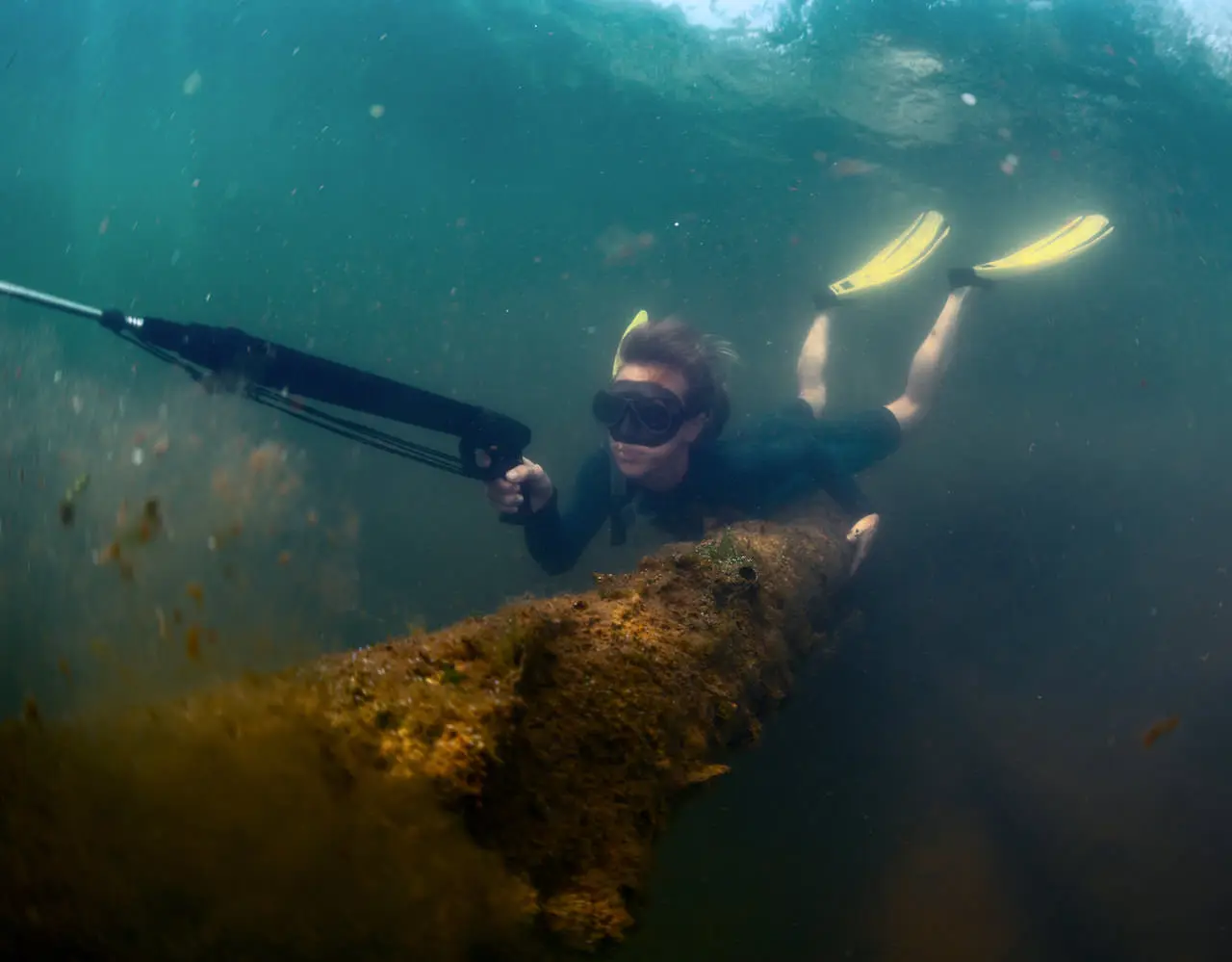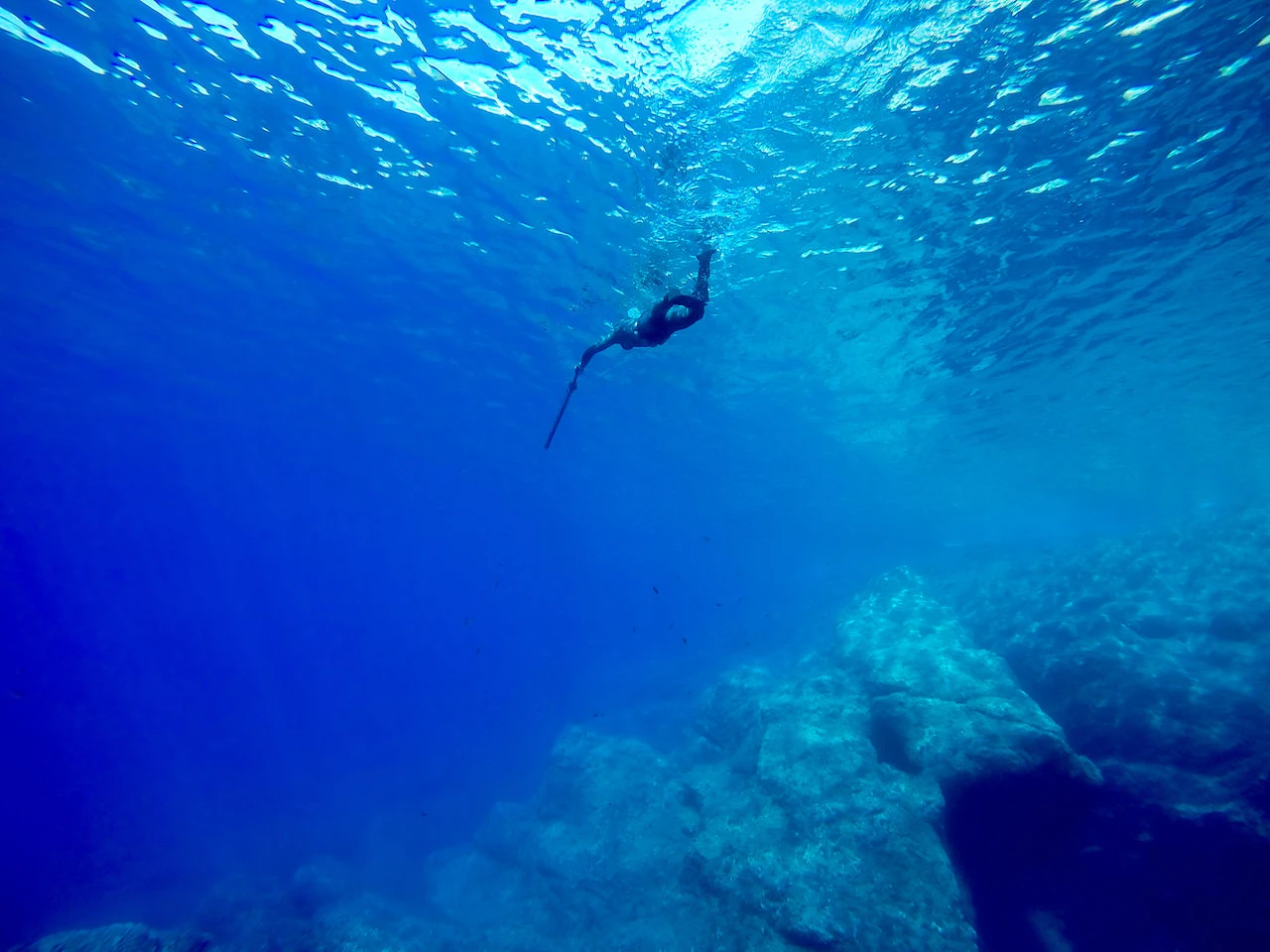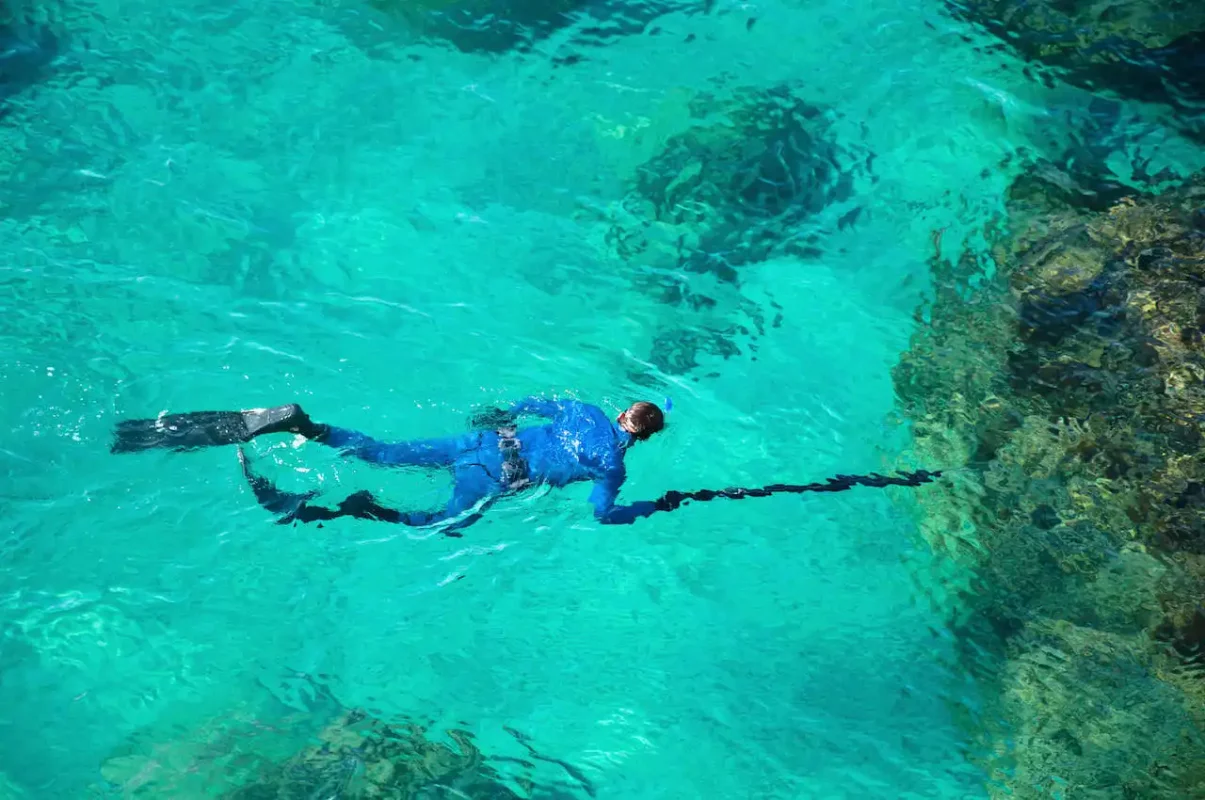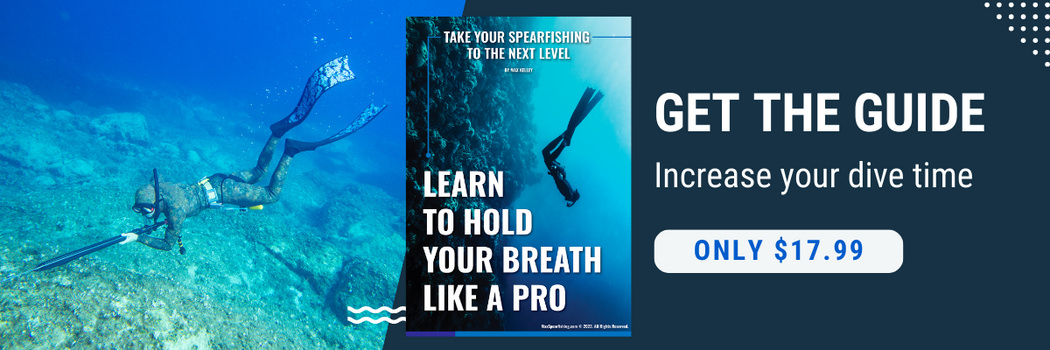No products in the cart.
Spearfishing Advice
Spearfishing Tips for Beginners Learning to Spearfish
If you’re learning how to spearfish, keep reading to discover the spearfishing tips for beginners I always recommend to newcomers to the sport.
Spearfishing is massively growing in popularity, for two reasons. It’s one of the most sustainable forms of fishing, with no bycatch or waste. And it’s incredibly meditative. You get to explore a whole other world, while being acutely aware of everything that’s happening in your body as you push your limits holding your breath.
For me, I’ve spent the better part of the last 30 years figuring things out on the water. In this post today I’d like to give you a “cheat sheet” or a spearfishing for dummies overview, so you can get started spearfishing without making all the same mistakes I did.
Max Spearfishing is reader-supported. We may earn a small commission for purchases using our links. Click here to learn more.
Spearfishing Tips for Beginners Learning to Spearfish
If you look back in time, spearfishing is an ancient hunting technique. Today, it’s rapidly gaining popularity as an adventure sport that gets you connected to the ocean, and up close and personal with your prey. Plus, it’s pretty fun kicking around in the ocean, looking for a fish to catch.
If you’re a beginner who is getting started spearfishing, it’s important you understand what you’re getting into, and the right way to do it. In this beginners guide to spearfishing, you’ll learn the spearfishing fundamentals you need to know, to learn and enjoy spearfishing safely and responsibly.
Approach spearfishing basics with the right mindset
One of the biggest frustrations from those who love spearfishing to newcomers to the sport, is that the newcomers generally don’t know what they don’t know.
Online you’ll see fish identification requests where a beginner has speared undersized or protected fish, purely out of ignorance. Or taking more than their bag limits because they had a “great day on the water.” Unfortunately this is where spearfishing get’s a bad name. And the fact that you’re reading this, is a great way to get started spearfishing the right way.
Because despite the fact we’re carrying an underwater equivalent of a rifle, most people who spearfish are big nature lovers. You’re jumping into the water every time you go spearfishing, and as a result you come to appreciate just how precious the marine ecosystem is. It needs to be protected, and that’s how most of us approach spearfishing.
Don’t do anything that damages the reef, and never leave behind and trash or fishing gear. Be highly selective of the fish that you do catch. Only take enough for your personal needs. And ensuring that what you do catch is both in season, and within legal catch limits.
Ultimately I want my kids to be able to enjoy spearfishing. And their kids. For generations to come. Spearfishing can be an incredibly eco-friendly activity when done responsibly.
Learn fundamental spearfishing techniques
Before diving into this sport, one of the most important spearfishing tips for beginners to learn are all the techniques. You need proper training and guidance from someone who knows how to spearfish, if you want to quickly progress.
My advice for anyone who wants to learn spearfishing basics, is to take a course. If that’s not possible, at least take a freediving course. So you learn the proper techniques for holding your breath underwater. Doing so under the guidance of a certified instructor will allow you to safely learn your breath holds and good diving techniques.
YouTube is another powerful resource, where you can tap into a wealth of knowledge about spearfishing, at the click of a button. I’ve also got a guide on how to hold your breath underwater, which walks you through all the techniques the professionals use to hold their breath for 2 to 3+ minutes underwater. Take the time to learn the basics and get a solid foundation for your spearfishing adventures.
And while you’re at it, get familiar with the rules and regulations in your local area.
There might be certain places you are not allowed to spearfish, you might need to purchase a special fishing license. And you’ll definitely find there are laws surrounding which species of fish you can spear, legal catch sizes and amounts, and at what times of the year you’re allowed to go spearfishing. Learn these, so you don’t get fined from a game warden for breaking the rules.
Get a good beginner speargun and spearfishing gear
Of course, you will need quite a bit of gear to go spearfishing. When I was first learning how to spearfish, I didn’t have much spearfishing equipment at all. Swimming out off the shore in a pair of boardshorts, with a pole spear, a snorkelling mask, and a set of fins was all I had. Needless to say, as eager as I was to learn spearfishing, much of what I did held back my progress.
Investing in a beginners speargun will make you much more effective underwater. You’ll land more of your shots at a greater range than a pole spear will give you, which is incredibly motivating when you’re first starting to go spearfishing. Then, you can make your time much more enjoyable with a few extra pieces of gear.
The right spearfishing wetsuit will keep you warm, so you can stay in the water longer. Buy a decent pair of spearfishing gloves, to protect your hands. Then you’ll need a weight belt in order to dive effectively into the hunting zone. Getting a dive knife is a must, as you’ll need it to dispatch any fish you catch, and I’d also recommend a float line and stringer. This allows you to store your fish a distance away (remember the sharks), and to also fly a diver below flag. So that any passing boats know you’re spearfishing in the area.
Oh, and you’re also going need the best speargun for beginners. I’ve tested a ton of spearguns in the years I’ve spent running this blog, and my advice is to get a Rob Allen speargun. With proper maintenance it’ll last for years, packs a ton of power, and is a perfect tool when you’re learning to spearfish.
No products found.
Get started spearfishing in shallow waters
For anyone who wants to learn spearfishing, one of the best ways to get started is in shallow water.
Find somewhere calm, protected, where there is shallow water and good visibility. That way you can get comfortable with all of your spearfishing equipment in a controlled environment, while still being able to stand up in an emergency. It’s the best way to master all the spearfishing basics.
Because things will happen that you didn’t plan for. Your mask might start fogging up and you’ve got to adjust it. You might get your shooting line tangled while you’re reloading your speargun. You might have challenges with the weights on your weight belt, and struggle diving. If I was writing a spearfishing for dummies book, the first chapter would be to get used to your gear and proper diving techniques, before venturing into deeper water.
Spend the first few minutes in the water ensuring your gear is working. Loading and firing your speargun at some weed, and that you’ve no trouble equalizing. Use your first few trips from shore to get used to handling your speargun. Reloading and targeting the skittish reef fish. Learn how to quickly dispatch your kills, and thread them onto your stringer. Once you’ve got a handle on this, swim a little deeper and start practicing your dives and breath holds. One of the most critical spearfishing tips for beginners, is you need to be confident before you push yourself too far.
In deeper water you’ll have currents and chop to contend with. The bottom might even be deeper than you’re able to reach. Bigger fish to target. Open water is where I love to go spearfishing, but beginners should get started in shallow water.
Study fish identification and their behaviors
One of my most valuable possessions when I was learning to spearfish was a field guide to the fish in my area.
After every dive I looked up the fish I’d seen, so I could accurately identify them next time. Doing so allowed me to know precisely what species I was targeting, along with the size limits I needed to stick within for that particular fish.
But what I also found valuable was learning about the feeding patterns, migratory habits and different habitats where I might find a particular species of fish. Sometimes the guides in your local fishing store will tell you. Other times you’ll need to figure it out yourself. Because the pro’s may not want a bunch of people heading to their secret spots they’ve discovered over a lifetime spearfishing. Remember, one of the key spearfishing tips for beginners is study, and putting what you’ve learnt into practice.
For the longest time, I’d heard about stories of “jewfish holes,” where large schools of Jewfish (also known as Mulloway), would shelter. But I never found one, until I spotted a jewfish swimming along the reef. Instead of taking a shot immediately, I hung back as I wanted to see where he was going. He led me right back to the hole where there we’re 20 to 25 even larger jewfish just hanging about. It’s a spot where 9 times out of 10, I’ll find jewfish inside. Still to this day.
Taking the time to study your target fish is important. Invest in a guide like the one below so you learn what fish look like underwater while you’re spearfishing, and learn where you’ll find them. It’ll help you quickly become better at spearfishing.
No products found.
Be patient and observe as you learn to spearfish
Probably the most effective piece of advice you’ll get from this spearfishing for dummies post is to be patient.
Effective spearfishing requires you to be patient. To remain calm. Doing so not only conserves your oxygen stores, it makes you less of a threat to any fish in the area. And that’s a good thing. Calm, controlled movements will allow you to get closer to your target fish. If you remember just one of these spearfishing tips for beginners, remember to be patient. It’ll give you a much better chance of landing the shot.
I also like to think we get a window into the underwater world on every dive. So make the most of it. Observe how the fish are swimming, and their movements along the reef. With time, you’ll be able to identify the patterns they’re swimming as they look for food. Which means you can better anticipate their behaviour, and choose the best ambush locations to start spearfishing from.You’ll find fish all over in the water, schooling in the wash around the rocks, cruising around on the bottom of the reef, and the deeper you go, the bigger the fish get.
To me, spearfishing is almost meditative. Spearfishing isn’t a sport you chase. It’s about being stealthy. Because even the slowest fish in the ocean is likely a better swimmer than you. Stay calm, and use a measured approach that won’t spook the fish you’re trying to hunt.

Spearfishing tips for beginners to hit their target fish
One mistake I see a lot of beginners make when they try to learn spearfishing is that they rush. They’re too excited.
When you see a fish you want to shoot, you need to relax. The fish won’t disappear unless you spook it, so stay calm. If you’re kicking around on the surface, try to imagine where the fish is going to swim to. Then take a breath, and dive down to your spot. Do it quiet and calmly though. If you’re kicking hard or making too much movement underwater, you’ll startle the fish and they’ll never get close.
Once you’re in position, flick the safety switch off and have your speargun ready. I like to extend my arm for additional range, and wait until the fish is within a few feet. That way, you’ve got a clear shot, while minimizing the chances you’ll miss. You’re aiming for the spot on the fish where the backbone connects to its head. Just behind the gills. If you get it right, you’ll “stone” the fish. And it’ll die instantly. If you happen to be a little off target, pull it in with your shooting line and use your knife to quickly dispatch it.
After this, I’ll slide the fish from my spear, and clip it onto my stringer. Reload my speargun, and I’m ready for the next shot.
Continuously improve your spearfishing skills
One thing I’ve learned over the years, is that you need constant practice to improve your spearfishing abilities.
You need to put in the time if you want to get better at spearfishing. Studying the theory and practicing the breath-hold exercises you need to hold your breath underwater for longer. It’s not a sport you can simply jump in the water and expect to excel at. It takes time to get comfortable with all your gear. It’s takes time to master the spearfishing basics.
When I’m not in the water, I make sure to spend a few minutes a day doing my lung expansion exercises. In the water, I like to take a few target shots at the beginning of eac spearfishing session. That way, I can perfect my aim, and ensure my spearfishing gear is all working as intended. You can also take courses that’ll push your freediving abilities, and get more comfortable underwater.
Embracing a mindset of continuous learning and improvement is an important spearfishing tip for beginners.
Don’t neglect safety when you’re starting spearfishing
This last of these spearfishing tips for beginners is critical. Because the open ocean is a dangerous place, and it’s important to keep yourself safe.
Find a dive buddy who can come with you as you’re learning to spearfish. If they have some experience you’ll learn a lot, and it’ll also give you someone you can rely on in an emergency. Someone who can pull you back to the surface if you push your limits a little too far and experience a shallow water blackout. Or help you get your catch into the boat. Someone watching out for you, and making sure there’s no sharks or other predators lurking just out of sight.
And the best part of not spearfishing alone, is that you’ll have someone who can vouch for all your new and exciting spearfishing stories.
Oh, and don’t forget all of your spearfishing safety gear. Especially a tow line, float and a dive flag. That way you’ve got something to hang onto if you get cramps or need to take a break on the surface, and any passing boats are able to quickly and easily see you while you’re spearfishing.

Wrapping up the spearfishing tips for beginners
Spearfishing is one of the most rewarding ways to spend your time. Diving and interacting with a whole other world, combining the trill of the hunt as you push your own limits to the bring. When you’re new to spearfishing, remember to prioritize your safety and take things slow a you learn the ropes. Remembering to respect the marine environment, the fish you’re catching, and the rules and regulations in your area. Pretty soon, you’ll love the ocean as much as well all do.
Happy spearin!


